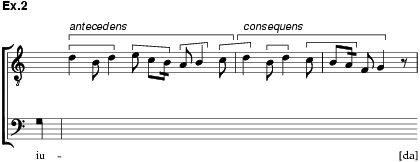
(copula: Lat.: ‘that which binds’, ‘a bond of several parts’; copulatio: Lat.: ‘the action of forming a bond’).
In the early 11th century ‘copulatio’ was used by Guido of Arezzo in the Micrologus to describe the symphoniae as ‘suaves vocum copulationes’ (CSM, iv, p.116). ‘Copula’ and ‘copulatio’ were often used for the ‘binding’ together of notes to form a melody, or of voices to form a polyphonic composition. ‘Copula’ was sometimes used in the later Middle Ages to denote the binding together of several notes in a ligature.
In the teaching of polyphony about 1100, as shown in the organum treatises of Milan and Montpellier, ‘copula’ generally referred to the final interval between voices at the end of a phrase (unison or octave), while ‘copulatio’ generally implied the establishment of that interval, that is, the progression from penultimate to final. The final note of the vox organalis could be decorated with a melisma, as prescribed by the fifth modus organizandi of the Milan treatise (see Eggebrecht and Zaminer, p.80). Ex.1 illustrates this. In the 13th century the short, rhythmically free linking passages or closing phrases of the three-part Notre Dame plainchant settings, found in two forms and called ‘copula ligata’ and ‘copula non ligata’ respectively by Franco of Cologne in his Ars cantus mensurabilis (CSM, xviii, pp.75–7), come very close to this idea of binding together at a cadence.

To Johannes de Garlandia, in the second quarter of the 13th century, ‘copula’ signified a compositional idiom, a style of setting in the Notre Dame repertory that falls ‘between discant and organum’ (De mensurabili musica, ed. Reimer, p.88). It has the strictly modally rhythmic upper voice of Discant, and the sustained-note tenor of Organum ‘in speciali’. The designation ‘copula’ probably refers less to the function such music may sometimes serve as a linking passage than to the stylistic compromise it represents between the idioms of discant and organum. It may also imply a type of strophic construction that is characteristic of much music in this idiom, for ‘copula’ and the Provençal word cobla were poetic terms for ‘strophe’. Garlandia explicitly described a copula passage in which the duplum divides, like a short strophe, into two parts of equal length and parallel musical structure (antecedens and consequens). Ex.2 shows a copula in the two-voice Alleluia Nativitas, with ouvert and clos endings. In Hiermonymus de Moravia’s reworking of Garlandia’s treatise, the musical and poetic meanings of copula are brought together when the theorist, listing several devices that could be introduced into a polyphonic setting to enhance its effect (‘loco coloris’), most likely at cadences, mentions both a ‘cantilena nota copula’ (‘well-known song, or copula’) and a ‘clausula lay’ (‘phrase of a lai’; ed. Reimer, p.97).

As a polyphonic idiom, Garlandia’s copula could be employed in any of the genres cultivated in the Notre Dame tradition. Its essential features – strictly patterned modal rhythm, symmetrical phrase structure – can be found throughout the two-voice organa, and they dominate the organa for three and four voices. Nevertheless, the distinction between copula and the other type of sustained-tone polyphony, ‘organum in speciali’, characterized by a free, unpatterned rhythmic flow, was largely a theoretical one, since it was formulated well after most of the music to which it was applied had been composed. In fact, much sustained-tone writing falls somewhere in between these two poles. Anonymous IV, writing late in the 13th century, subsumed both idioms under a single category, organum purum.
Passages of copula seem often to have been singled out for special treatment in performance. Franco remarked that the copula was performed much faster than the notation suggests, probably a reflection of the cadential function that the idiom serves in his system. Anonymous IV mentioned distortion in performance of the durational values in the rhythmic modal patterns and unpatterned rhythmic designs used in organum purum (he called these liberties ‘irregular modes’), and cited a specific passage from Perotinus’s three-voice Alleluia Posui adiutorium, which he says is ‘loco copulae’, as an example (ed. Reckow, i, p.84). The St Emmeram Anonymous alluded to the ‘more delicate way and more subtle voice’ used in the performance of copula, a style that he equated with the rendition of organum ‘in speciali’, which is ‘wreathed in a melodious sound’ (ed. Yudkin, p.276). Thus, over the course of the 13th century the meaning of the term was expanded to embrace not only a polyphonic idiom and, occasionally, the function within the larger composition in which copula appears, but also a performance style.
See also Magnus liber and Rhythmic modes.
W.G. Waite: ‘Discantus, Copula, Organum’, JAMS, v (1952), 77–87
F. Reckow: Der Musiktraktat des Anonymus 4 (Wiesbaden, 1967)
R. Flotzinger: Der Discantussatz im Magnus liber und seiner Nachfolge (Vienna, 1969)
H.H. Eggebrecht and F. Zaminer: Ad organum faciendum: Lehrschriften der Mehrstimmigkeit in nachguidonischer Zeit (Mainz, 1970)
F. Reckow: ‘Copula’ (1972), HMT
F. Reckow: Die Copula: über einige Zusammenhänge zwischen Setzweise, Formbildung, Rhythmus und Vortragsstil in der Mehrstimmigkeit von Notre-Dame (Wiesbaden, 1972)
E. Reimer, ed.: Johannes de Garlandia: De mensurabili musica (Wiesbaden, 1972)
J. Yudkin: ‘The copula according to Johannes de Garlandia’, MD, xxxiv (1980), 67–84
E.H. Roesner: ‘Johannes de Garlandia on organum in speciali’, EMH, ii (1982), 129–60
J. Yudkin: ‘The Anonymous of St Emmeram and Anonymous IV on the Copula’, MQ, lxx (1984), 1–22
J. Yudkin, ed. and trans.: De musica mensurata: the Anonymous of St. Emmeram (Bloomington, IN, 1990)
S. Pinegar: Textual and Contextual Relationships among Theoretical Writings on Measurable Music of the Thirteenth and Early Fourteenth Centuries (diss., Columbia U., 1991)
For further bibliography see Organum and Discant.
FRITZ RECKOW/EDWARD H. ROESNER